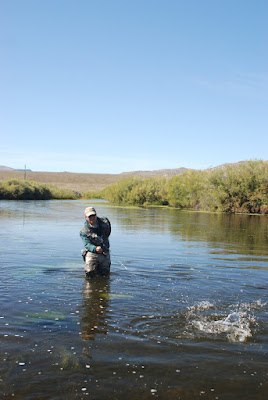 |
| The most important tool in a trout angler's kit |
Poll question of the day: What is the most important tool in a trout angler's kit? If you answered “stream thermometer” quit reading and go fishing.
Based based on countless conversations with fellow anglers, how water temperatures affect trout be-havior and thus our fishing success is the least understood piece of the fly fishing puzzle. In an effort to solve the puzzle, I set a course to learn as much as possible and so what follows is the result of decades spent talking to biologists, reading everything I could get my hands on, combined with decades of steadfast stream thermometer use and studious observation. As with most investigations some of the stuff I uncovered seemed spot on and, of course, some of it didn’t quite fit my personal observations.
Anyway, here ya go:
•
The ideal water temperature for brown trout is about 60°F; for rainbow and brook trout a cou-ple degrees less.
•
Trout are most active at their individual ideal water temperature. In general trout (aquatic food chain) engines are firing on all cylinders in water ranging from 55-65°F.
•
Oxygen plays a major roll. Oxygen levels rise and fall more or less in direct relationship to both water temperature and flow rate. Fast water always contains more oxygen.
•
On the high end, once temperatures reach about 70-72°F metabolisms slow down and trout begin to migrate to cooler, more oxygenated water—deep pools, riffles, runs and in extreme situations, often abandon completely long stretches of the main stem, migrate long distances to spring holes and/or mouths of cold tributaries.
•
On the low end, once water temperatures fall to the low 50s metabolisms slow down. But, de-spite the higher oxygen levels in fast water, trout migrate to deep, slow pools to conserve energy.
•
The good news is once the trout become conditioned to lower water temperatures they still must eat. As a rule of thumb fish low and slow. Even in dead of winter trout often gang up in eddies and backwaters to gorge on hatching midges.
•
Two words I’ve learned to never utter in a fishing discussion are “always and never.” So yes, some trout become conditioned to higher and lower water temperatures and thus fall outside the above parameters. The Firehole is a good example on the high end and the San Juan, below Navajo Dam, where the water enters at a chilly 39°F year around, is a prime example on the low end.
•
Because of depleted oxygen levels at both ends, anglers need to bring trout to hand quickly, get the hook out and back in the water pronto—or kill it—your call. But trust me any trout mishandled even a little bit, in 70°F+ water is in serious jeopardy. At the low end not so much but still the quicker the ordeal the better.
•
The faster the water temperature is rising above or falling from the ideal the slower the fishing.












